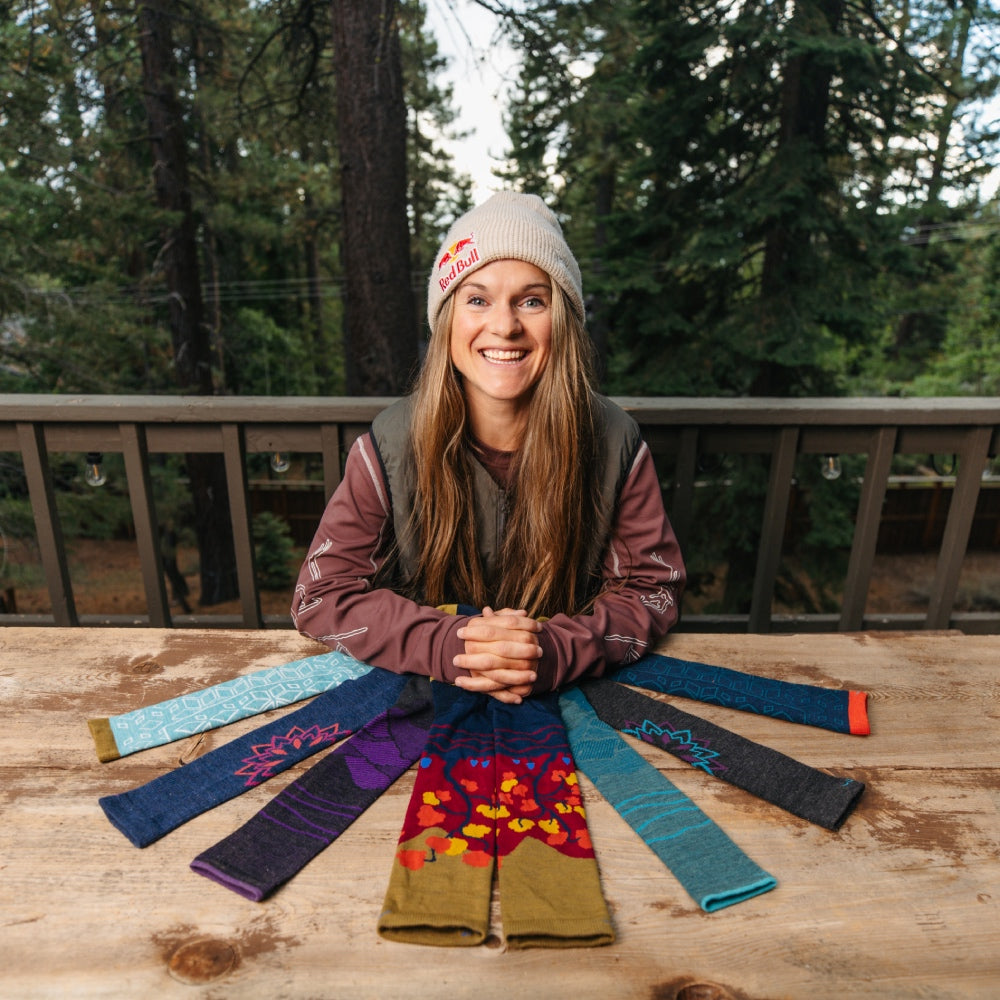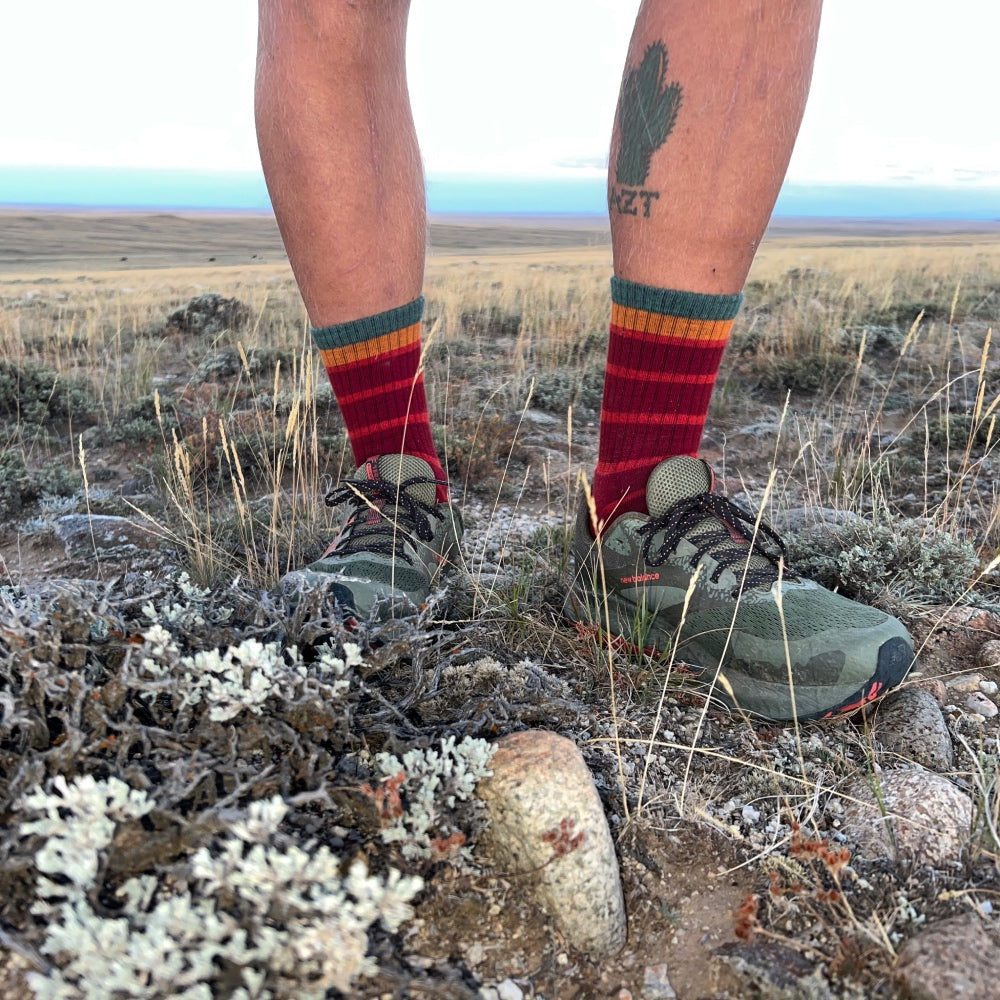Unlocking the Science of Merino Wool Fibers

While you may already know that Merino Wool is a favorite for outdoor enthusiasts, have you ever wondered about what exactly makes Merino Wool so exceptional for high performance activewear?
The science behind wool is both fascinating and intricate. So, buckle up! We’re about to step into the realm of microns and molecules to explore how nature’s original performance fiber naturally elevates your outdoor adventures.
Understanding Merino Wool

Wool is one of the world’s oldest natural fibers, developed and evolved to stand the test of time. Each year, sheep produce a new fleece which is shorn seasonally to yield high-quality fibers that create your trusty, comfortable performance wear (including socks).
Straight from the sheep’s back, wool is made of the proteins, lipids, and minerals that are naturally absorbed through a sheep’s diet. This results in a fiber that is composed of about 97% protein and 2-3% lipid material.
Merino Wool is chemically and structurally much like the hair found on other animals – including humans. But human hair and Merino Wool are different in their structure and chemical components. In comparison to human hair, Merino Wool:
- Is finer and softer to the touch, on average about one third the diameter of human hair.
- Performs better for insulation.
- Is more breathable and capable of moisture transport.

It’s Merino Wool’s remarkable comfort, breathability, and ability to manage moisture and temperature, as well as durability, that make it so sought after for performance wear.
Even better, the Merino Wool fiber is the ultimate example of many parts working as one, where multiple areas of the fiber interact to create a soft, breathable fiber capable of excellent odor control and moisture management to keep you comfortable and at your best.
What are the elements inside of the Merino Wool fiber that make it ideal for performance wear, including your trusty socks? Let’s break down the different components of the Merino Wool fiber for a closer look.
The Cuticular Scale: The Science of Comfort
You may have heard of Merino Wool’s reputation for comfort but might be wondering what exactly makes it so comfortable? The outermost portion of the Merino fiber, the cuticular scale, is part of what gives wool its softness, breathability, and water repellent properties.

Soft & Smooth
The cuticular scale of the wool fiber is responsible for softness. The cuticular scale determines the diameter – or thickness or width – of the fiber. Merino Wool’s comfortable feel is because of its smaller fiber diameter, which is measured in microns (one micron is equal to one millionth of a meter!).
Commercially, Merino Wool fibers mainly range from about 13.5 to 32 microns. Fine Merino Wool fibers under 18 microns provide great next-to-skin comfort, which is perfect for comfortable socks. Broader fibers in the range of 18-22 microns are ideal for soft mid-layers and outerwear clothing.
For comparison, human hair ranges between 50 to 100 microns, while other fibers such as silk range from 7 to 16 microns, and cashmere generally less than 18 microns - just a friendly reminder of why Merino Wool is in a league of its own.
The fine diameter of the softest Merino Wool makes it incredibly comfortable and gentle against the skin, avoiding both itch and irritation, as it can bend when it comes into contact with skin. Additionally, it’s this fine diameter that is partly responsible for making things like socks made from Merino Wool so comfortable.
Another bonus? Wool is hypoallergenic, which means it's less likely to cause allergic reactions in people with sensitive skin.
In addition to softness, the cuticular scale decides the drape of wool fabrics, or the way fabric hangs or falls when draped across a surface such as a person’s body. This is important because fine and soft Merino Wool fibers can be spun into yarns to make fabrics with smooth, comfortable drape.
All these excellent attributes make Merino Wool the finest and softest wool in the world. No wonder slipping into a pair of Merino Wool socks feels so cozy!
Breathable & Water Repellent
Two other benefits of the wool fiber that are also attributable to the cuticular scale are its breathability and hydrophobic properties. While this might sound complicated, it’s nature’s brilliance at work!
The breathability of the wool fiber comes from how the cuticular scales draw sweat and moisture vapor away from the body to then release it out into the air. This helps to regulate body temperature and keep you comfortable no matter the temperature outside.
Similar to water repellency, the hydrophobic nature of the outer wool fiber partly depends on the cuticular scales to help fend off moisture, preventing it from seeping deep into the fiber.
Wool’s hydrophobic properties keep garments dry and breathable, regulating body temperature, and transporting moisture away from the skin. We know that no one likes wearing wet socks, and we also know that Merino Wool helps to keep your feet dry and comfortable, even in wet conditions.
The Orthocortex & Paracortex: Where Thermoregulation Lives
At the heart of wool’s thermoregulation ability lie two essential components of the wool fiber: the orthocortex and the paracortex.
Sitting alongside each other in an unevenly distributed pattern, the orthocortex and paracortex create the crimp of the wool fiber. The crimp, or waviness, of the wool fiber is what gives wool fabric part of its breathability and temperature management qualities, as well as playing a part in softness and comfort.

The crimp works to trap static air between the skin and the wool fabric, creating a microclimate next to the skin, keeping your feet just the right temperature. This function not only insulates you from cold weather, but it also provides evaporative cooling in hot weather.
This means you’ll win either way with wool, whether you’re keeping cool when it’s hot or rugging up when it’s cold.
Cortical Cell & Cell Membrane Complex: Incredible Durability
Nestled inside the protective casing of the cell membrane complex is a structure called the cortical cell that gives Merino Wool its strength, abrasion resistance, and durability.
The cortical cell is made from a crystal-like structure – called the crystalline region – which has a highly ordered molecular arrangement, like crystals. This imparts mechanical properties to the fiber that include strength to withstand bending or stretching and structural integrity even under strain.
The non-crystalline region sits alongside the crystalline region. Unlike its neighbor, the non-crystalline region is less organized in its molecular arrangement and is responsible for the flexibility of the fiber. The non-crystalline region is also high in sulfur, which can absorb dyes to give longer lasting colors that don’t bleed in the wash or fade out over time!
The combination of the crystalline and non-crystalline regions inside the cortical cell gives a delicate balance between strength and flexibility while remaining pliable and soft to touch, making wool a durable fiber even for the toughest conditions.
The Matrix: Banishing Moisture & Odor
Ever seen a sweaty sheep? Neither have we. Merino Wool is made from a physical and chemical structure that helps it to manage moisture and odor – perfect for high intensity exercise.
In the Merino Wool fiber, multiple elements play a crucial role and work together to achieve outstanding results to make it the ultimate all-round fiber. Now, you already know about the Merino Wool fiber’s ability to repel moisture. But did you know that it can also absorb moisture and odors?
Merino Wool has an additional element that contributes to its odor and moisture management properties. But what is it?
It’s called the matrix – and no, we’re not talking about the 90’s movie. The matrix of Merino Wool is the non-crystalline region found deep inside the fiber and is made from high-sulfur proteins which possess special properties that allow them to effectively absorb moisture and odors.
The matrix has hygroscopic properties, which means it can absorb and retain liquid moisture from the surrounding environment, including sweat from our skin as well as moisture vapor from areas of high humidity next to the skin. In fact, the fiber can absorb up to 30% of its own weight in moisture without even feeling wet.
The high-sulfur proteins in the matrix capture odor-causing molecules generated by sweat. This action creates a natural odor-control mechanism that keeps you fresh even after long wears.
When sweat on the skin releases the odor-forming molecules, these molecules can migrate into the wool fiber and attach to polar amino acids within the matrix. The odor molecules are held by the fiber until the next wash to minimize unwelcome smells that are only released upon washing. This natural ability also means that you can wear wool for longer as it needs less frequent washing.
Goodbye, smelly socks!
This is just another reason why Merino Wool is the secret weapon for performance wear, keeping you fresh and at your best, no matter the adventure.
The Keratin Molecule: Incredible Recovery
A fundamental building block of the wool fiber, the keratin molecule provides elasticity and recovery from wrinkling. Because of the keratin molecule’s spiraled helix shape, wool can recover quickly from being folded or compressed.
The spiraled keratin molecule gives wool the ability to bounce back, like a spring, without losing its integrity or shape.
From Humble Sheep to Mountain Tops

These are just some of the many benefits of Merino Wool for sportswear, which we’re sure you’ll agree, are outstanding for a fiber that comes from the humble sheep!
While we know that Merino Wool is a remarkable performance fiber on its own, the fiber’s capabilities can be boosted when it’s strategically paired with other performance fibers to enhance these properties for optimal results.
Keen to put Merino Wool sportswear to the test? Check out Darn Tough Merino Wool socks for your next outdoor adventure. If this journey through the wool fibre has sparked a fresh interest in wool, learn more about Merino Wool’s properties through Woolmark’s free online courses.
About the Author
The Woolmark Company is a subsidiary of Australian Wool Innovation, a not-for-profit enterprise owned by more than 60,000 woolgrowers that invests in research, development, and marketing along the worldwide supply chain for Australian wool. We encourage and unite the entire supply chain, by connecting, inspiring and educating, guaranteeing wool fiber quality, collaborating with like-minded brands and championing the wool fiber’s eco-credentials.
All photos in this post are courtesy of the Woolmark Company.







